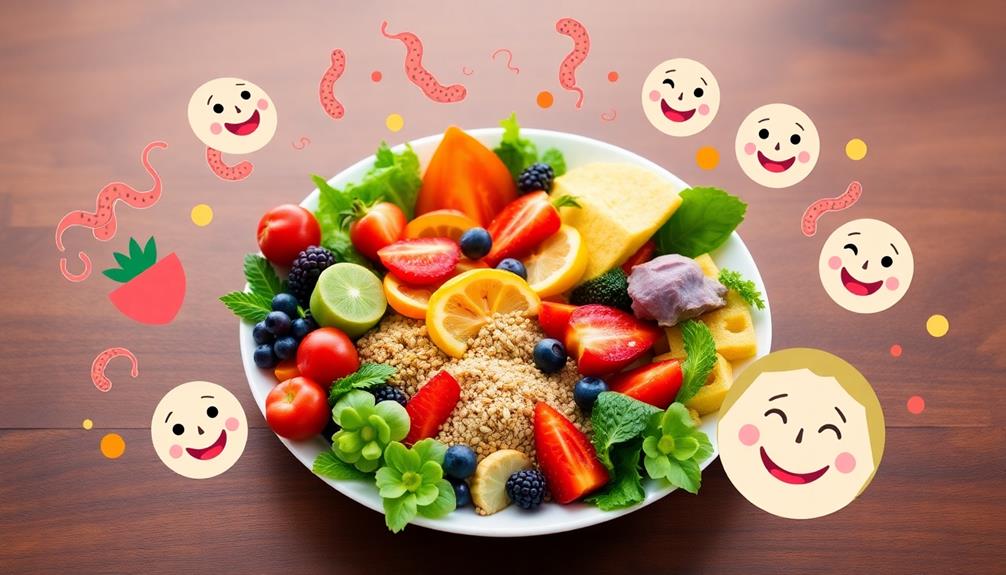Did you know your gut bacteria can affect your mood? It's true! Here's how your tummy and feelings are connected:
- Your gut makes over 90% of serotonin, a key mood booster.
- Healthy gut bacteria help keep anxiety and sadness in check.
- Foods like yogurt, bananas, and garlic can make your gut happier.
When your microbiome is balanced, you'll likely feel better and less stressed! So, next time you enjoy a tasty yogurt or a banana, remember it might brighten your day. Want to uncover more about this fascinating connection? There's so much more to discover!
Key Takeaways
- The gut microbiome produces over 90% of serotonin, a neurotransmitter crucial for mood regulation.
- Imbalances in gut bacteria can lead to increased anxiety and depression symptoms.
- Consuming fermented foods and prebiotics supports the growth of beneficial gut bacteria, enhancing mood.
- Regular physical activity positively influences gut health, reducing anxiety and depressive symptoms.
- Research shows a strong connection between a balanced microbiome and overall mental well-being.
Understanding the Gut-Brain Connection

When you think about your mood, you mightn't immediately consider your gut, but the connection between these two systems is profound. The gut microbiome, which is made up of trillions of tiny microorganisms, plays a big role in how you feel! It communicates with your brain through pathways like the vagus nerve.
Notably, the foods you eat can influence your gut health, and incorporating dishes like Mushroom Masala can provide beneficial nutrients for your gut bacteria.
Did you know that over 90% of serotonin, the happy chemical in your brain, is produced in your gut? That means your gut bacteria are essential for your emotional well-being. When your gut is healthy, it can help you feel happier and more balanced.
Research, especially from animal models, shows that if your gut bacteria aren't right, your mood can change. For instance, germ-free mice show more anxiety and less sociability.
But don't worry! Probiotics, like Lactobacillus rhamnosus, can help. These friendly bacteria have been linked to better mood and less anxiety in studies.
Mental Health and Gut Imbalance

An imbalance in gut bacteria can have a significant impact on your mental health. When your gut isn't healthy, it can lead to feelings of depression and anxiety. This is because certain bacteria, like *Eubacterium ventriosum*, are important for keeping your mood steady. If these bacteria decrease, you might feel down more often.
Additionally, incorporating nutrient-rich foods, such as those found in farm-to-table cooking, can support gut health and improve your overall mood. Did you know that over 90% of serotonin, a key hormone that helps with mood, is made in your gut? That's right! Your gut microbiota plays a big role in producing neurotransmitters that affect how you feel.
If your gut is inflamed, which can happen when the bacteria aren't balanced, it might lead to mood swings and symptoms that feel like depression or anxiety.
Here are some key points to remember:
- An unhealthy gut can lead to increased anxiety.
- Gut bacteria help produce important mood-regulating hormones.
- A balanced microbiome is key for mental well-being.
Strategies for Enhancing Gut Health

To enhance your gut health, focus on incorporating a variety of strategies that not only nourish your body but also support your mental well-being. A healthy gut can make a big difference in your mood!
Here are some fun ways to boost your gut microbiota:
1. Enjoy Fermented Foods: Add yogurt, kefir, and sauerkraut to your meals. These tasty treats are packed with beneficial gut bacteria that can lift your spirits!
You can also try traditional Indonesian desserts like Kue Putu to enjoy a sweet treat while supporting your gut health!
2. Choose Prebiotic Foods: Garlic, onions, and bananas help healthy gut bacteria grow. They're not just good for you—they're delicious too!
3. Stay Active: Regular physical activity isn't just great for your body; it can improve your gut health and reduce feelings of anxiety and depression.
Get moving with fun games or family walks!
4. Consider Probiotic Supplements: If you're looking for an extra boost, try probiotic supplements, especially those with Lactobacillus rhamnosus. They can help with mood and mental health.
If you also follow a Mediterranean diet filled with fiber and healthy fats, you'll be well on your way to a happy, healthy gut.
Enjoy your journey towards better gut health!
The Role of Diet in Mood

Diet plays an essential role in shaping your mood and emotional well-being. What you eat can really influence how you feel! A diet rich in fermented foods, like yogurt and kimchi, can boost the good bacteria in your gut. These probiotic bacteria help connect your gut and brain, which is important for your mental state.
Incorporating traditional Japanese dishes, such as Dorayaki (Red Bean Pancake), can also contribute to a balanced diet that supports mood enhancement. Here are some exciting ways your diet can help with mood:
- Fiber-Rich Foods: Eating whole grains and fruits can increase the production of short-chain fatty acids (SCFAs), which support mood regulation.
- Mediterranean Diet: This diet is packed with fibers and fermented foods, and studies show it's linked to better mood and less anxiety and depression.
- Stress Response: A healthy gut can help your body handle stress better, making you feel more balanced.
Choosing the right foods can be a fun way to improve your mental health! By making simple dietary interventions, you can help your gut microbiome thrive, leading to a happier, healthier you.
Future Directions in Research

Researchers are diving into the fascinating connection between gut bacteria and mood, aiming to uncover new insights that could transform mental health treatments. As they explore this exciting area, future research could lead to some great breakthroughs!
Here are a few directions scientists are heading in:
- Larger Studies: They're planning bigger, more rigorous human studies to validate how specific gut bacteria affect mental health, especially in cases of depression and anxiety. This is similar to how traditional Chinese dishes are carefully prepared to achieve specific flavors and health benefits.
- Gut-Brain Communication: Investigating how the gut and brain talk to each other, including the role of the vagus nerve, is essential for understanding the relationship between gut bacteria and our feelings.
- Psychobiotics: Clinical trials are underway to test psychobiotics, which could help ease symptoms of various mental health issues.
- Food Diets: Researchers are looking into fiber-rich and fermented food diets to see how they change our gut microbiome and improve mental health.
With these exciting advancements in probiotic research and diet, we're getting closer to understanding how our immune systems, food choices, and gut health can boost our mood!
Frequently Asked Questions
How Are Gut Bacteria Connected to Your Mood?
Your gut bacteria influence your mood by producing neurotransmitters, including serotonin. An imbalance can lead to increased anxiety or depression. Eating a fiber-rich diet and fermented foods can help maintain a healthy gut microbiome.
Is Gut Bacteria Linked to Mental Health?
Think of your gut as a bustling city; its bacteria influence your mental health. Yes, gut bacteria are linked to conditions like anxiety and depression, so nurturing them could brighten your mood and enhance well-being.
How Can Gut Bacteria Influence Behavior?
Gut bacteria influence your behavior by producing neurotransmitters and communicating with your brain. By maintaining a healthy microbiome through diet, like fiber and fermented foods, you can enhance emotional regulation and overall mental well-being. Additionally, research suggests that an imbalance in gut bacteria may even exacerbate symptoms of anxiety and depression, further highlighting the importance of gut health. On the other hand, the effects of food dyes on children have raised concerns regarding behavioral changes, such as increased hyperactivity. By prioritizing whole, nutrient-dense foods, you can support both gut-brain communication and overall mood stability.
What Have Scientists Discovered About the Relationship Between Gut Bacteria and Serotonin?
Imagine your gut as a bustling city, where friendly bacteria like *Lactobacillus* and *Bifidobacterium* generate serotonin. Scientists found that these bacteria directly impact serotonin levels, influencing your mood and emotional well-being considerably.
Conclusion
To sum up, taking care of your gut can bring joy to your mood! Just like how a superhero saves the day, a happy tummy can help you feel brighter and more cheerful. By eating yummy foods, staying active, and knowing how our gut works, you can boost your happiness. So, let's celebrate our gut health together! Remember, a happy gut leads to a happy heart, and that's something worth smiling about every day!










